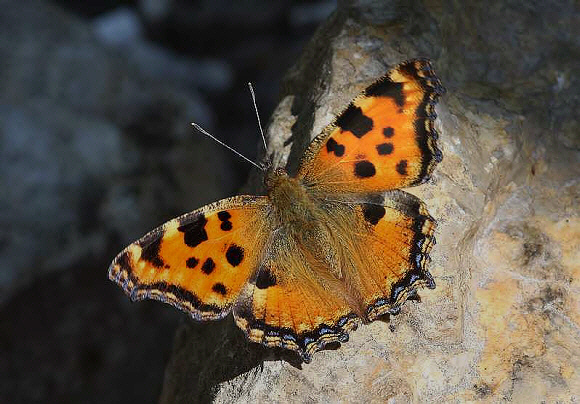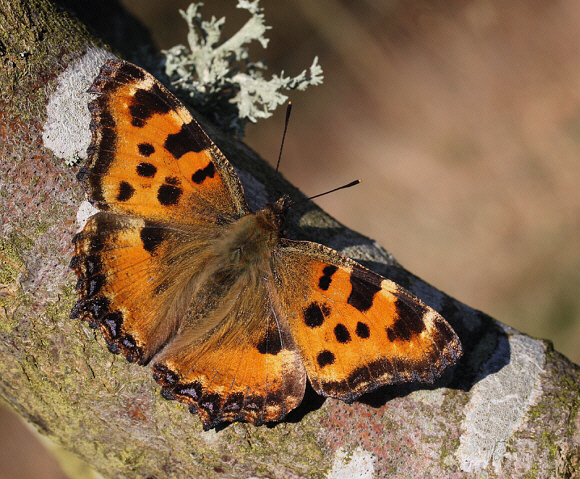
Nymphalis polychloros – Peter Bruce-Jones
Introduction
The Large Tortoiseshell is widely distributed in Europe, and common in the Mediterranean region where it breeds in open woodland areas. It also occurs in Morocco, Algeria and Tunisia; and across temperate Asia from Turkey to Kazakhstan and the foothills of the Himalayas. It can confused with the similar Yellow-legged Tortoiseshell Nymphalis xanthomelas which has much brighter and redder colouring, and enlarged blue lunules on the hindwings. The latter species is only found in eastern Europe and temperate Asia, where it breeds in wooded river valleys. Old records of it’s occurrence in Britain are dubious.
 Nymphalis polychloros – Lars Anderson
Nymphalis polychloros – Lars Anderson
Habitats
A century ago the Large Tortoiseshell was a common butterfly in southern and eastern Britain. It had always been subject to periodic fluctuations in abundance, but declined very suddenly in the early part of the 20th century, and apart from a short period of abundance in the 1940’s never recovered. By the 1970’s it had become a great rarity.
The butterfly’s decline was originally attributed to increased parasitism but I believe this is unlikely. Parasitoid / host abundance is normally cyclic, and linked to the differing climatic requirements of host and parasitoid. After a period of parasitoid-induced scarcity, butterflies generally recover and return to abundance until climatic conditions again favour the parasitoid.
Whatever the cause of the decline, it was certainly exacerbated by the arrival in Britain in 1976 of a particularly virulent strain of Dutch elm disease, which rapidly proceeded to almost eradicate the main larval foodplants wych elm Ulmus glabra, and English elm U. procera. The disease arrived in Britain on logs imported from North America, and quickly spread across the country, transported by Scolytus elm bark beetles. These live under the bark, and propagate an ascomycete microfungus Ophiostoma novo-ulmi which is responsible for the disease.
By 1990 the Large Tortoiseshell was considered to be either extinct or on the verge of extinction in the UK. It has been suggested by some that it still maintains its presence as a breeding resident in southern England, but that populations have become reduced to the point where the butterfly is now unobservable. It seems very unlikely though, as the very conspicuous larval nests would surely still be found occasionally. None have been reported in Britain for several decades.
Since 1998, sporadic sightings of adults have been reliably reported from sites along the south coast of Hampshire and Dorset. Most of these records have referred to very worn post-hibernation insects seen in early spring. It is unknown whether these represent the progeny of migrants or of captive bred stock. In June / July 2007 fresh specimens were seen at several locations on the Isle of Wight and scattered along several miles of the Hampshire coastline.
Records of overwintered specimens from other coastal sites every spring from 2007 to 2012 appears to indicate that the butterfly is now breeding regularly in low numbers on the Isle of Wight and possibly elsewhere long the south coast although no larvae have been recorded. It is however possible that one or more amateur breeders may be releasing captive-bred European livestock of this butterfly in an attempt to re-establish the species in Britain.
In Europe the Large Tortoiseshell is usually encountered as singletons. It is encountered widely but never in numbers. It is a highly mobile species and breeds in forests and along hedgerows where elms Ulmus glabra & U. procera, sallow Salix caprea, poplars Populus alba & P. nigra, wild cherry Prunus avium, or aspen Populus tremula grow.
Lifecycle
The adults emerge in late June or early July, but are only active for about a fortnight, as they enter hibernation very early – typically in late July, and are not seen again until the following spring. The eggs are laid in April, and hatch after about 3 weeks. They are laid in large batches in a neatly arranged ring around twigs, about 2-4 metres up, on the sunny side of various trees, but particularly on wych elm Ulmus glabra. The larvae are black, covered with sharp orange spikes and peppered with tiny white dots, giving them a greyish appearance.
They live communally in conspicuous silk webs spun on the twigs of the foodplants. If they are disturbed by a bird the whole group jerks in unison. As they grow older they split into smaller groups, and become solitary just prior to pupation. When fully grown in early June, the larvae descend from the treetops, and wander a short distance to pupate.
The pupa is brown, marked with gold spots, slightly spiky in appearance, and resembles a withered dead leaf. It is formed hanging by the cremaster from twigs or branches on the lower part of various bushes and trees. In Turkey I have found them commonly suspended from the walls and eaves of buildings. In my experience at least 60 percent of pupae are found to be parasitised.
Adult behaviour
Males are seen as solitary individuals, usually either in flight, or when basking on bare ground in lightly wooded habitats. In Britain they have been reported nectaring at sallow catkins in spring, and bramble blossom and various herbaceous garden plants in summer.
Females habitually bask on tree trunks, often in a head-downwards posture. The males patrol along wood edges until they locate a female, and then settle beside it. The female then flies off, with the male in hot pursuit, until after an hour or more the pair settle on a tree trunk and copulate. They remain paired all afternoon, and possibly overnight.
In Europe they are sometimes seen flying around the tops of sallows, elms and poplars, but are normally encountered in flight, when dispersing in search of breeding sites. In western France I’ve observed them flying in inhospitable terrain including motorway car parks, petrol stations and town centres, indicating that the species is highly mobile and probably migratory in behaviour.
Near Dijon in central France I once found 3 Large Tortoiseshells clustering together in the company of several bees and a dozen Woodland Graylings, all feeding at a sap run on a hedgerow hawthorn. While feeding the Large Tortoiseshells nervously fanned their wings, but made no attempt to fly away even when I approached very closely. However on other occasions when I’ve encountered this species, they have been extremely wary.
In Turkey I have found recently emerged butterflies hanging from twigs along dry river beds. They remained aestivating on the twigs for several days in late May.
